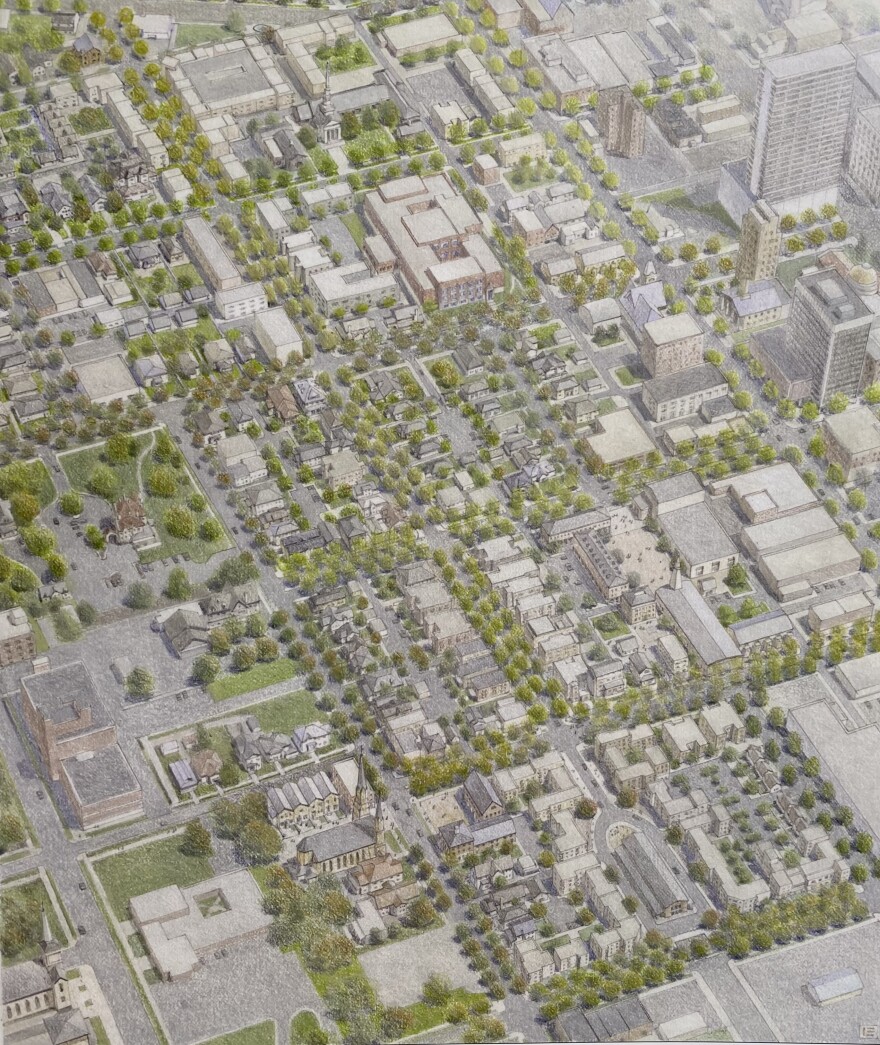This spring, students at the Notre Dame School of Architecture developed a plan to reimagine South Bend’s William Street corridor. The city has expressed interest in some elements of the plan, which aims to connect Downtown to the Near West Side.
“Downtown has a very distinct character, and the Near West Side has a very distinct character,” Tim Corcoran, South Bend’s director of planning and community resources, said. “But there’s this area between the two that doesn’t feel like it belongs in either of those two places.”
Students worked with several professors, as well as the city and community members, to develop the plan last January. It lays out a re-imagined urban neighborhood centered on William Street between Lincolnway West and Western Avenue.
“Every day as I went to school at Notre Dame, I would pass that site,” Christian Johnson, a former Notre Dame architecture student and Near West Side resident, said. “It gave me a little more insight and empathy for what I was working on.”
The students’ plan would add 450 housing units of mixed density — from single family homes to duplexes and apartment buildings — as well as new commercial spaces, a market hall, traffic calming measures, new parks and a community center.
Corcoran said the William Street corridor had more housing before it was connected to Lincolnway and Portage. After that, he said people began using it as a traffic cut through, and urban renewal led to a lot of vacant land and parking lots.
But the plan is just a student project for now — Corcoran said it’s far from a done deal.
“Are there ideas in here that will happen? I have no doubt that there are ideas that will happen,” Corcoran said. “Will the whole thing happen as presented? Probably not.”
The two most likely things to be implemented, Corcoran said, are traffic calming measures and city zoning changes allowing for more dense housing. South Bend could roll some of those elements into the separate, city-run Near West Side Neighborhood plan when it’s adopted later this year.

Donnie Rogers is on the board of the Near West Side Neighborhood Organization. He owned an office on William Street for 17 years and has lived near the corridor for the last two.
He also attended some of the virtual meetings Notre Dame students held while developing the plan.
“It’s got some good ideas should developers come forth, should the city decide to look at it with an eye toward how they might like to develop things,” Rogers said. “It’s a good sort of optimistic, 30,000-foot view of what could be done with the community.”
Although the plan is hypothetical, Rogers said he’d be concerned about gentrification if it was implemented. He doesn’t want to see William Street become the next Eddy Street Commons, where he said “entire neighborhoods have been displaced.”
“There’s a fabric to our neighborhood,” Rogers said. “Everyone wants to see their neighborhood get better, but we don’t want to see the people who make that fabric of the neighborhood get pushed out.”
The plan doesn’t have any specific affordable housing details, but building a large number of mixed density units could create some cheaper options.
Corcoran said the city would work with partners like the housing authority to make sure affordable options would be included. But, he said the city’s role would mostly be to facilitate zoning changes and lay the groundwork for private projects.
“The city doesn't build houses,” Corcoran said. “The city sets the land use framework for houses to be built and we put the infrastructure in the ground to facilitate that.”
He pointed to the riverwalk neighborhood near Howard Park as an example — there, the city rebuilt the streets and “sort of set the scene” for private development, he said.
And in the case of William Street, Corcoran said much of the existing infrastructure is underutilized and can support new development without significant upgrades.
“The desire for more urban living has been a trend that’s happening across the United States, for places that are walkable, have a lot of different amenities nearby,” Corcoran said. “Williams Street is a perfect place that can offer many of those amenities.”

If parts of the plan are implemented, Rogers said current residents should be a part of that process.
“We don’t want to steer the ship, but we want to at least look at the map and help guide the path,” Rogers said. “Because it’s our neighborhood. We live here for a reason – we love it here, and we like the diversity.”
Corcoran agreed, saying a project as large as the students’ plan would be adopted incrementally, with community feedback at each stage.
“At the end of the day, every plan gets implemented with continuous public input,” he said.
Corcoran said people who are interested in the Notre Dame plan or the Near West Side Plan plan should go to the city’s website
The city is currently conducting an online community survey to develop its Near West Side Neighborhood Plan, and Corcoran encouraged people interested in either plan to fill it out — you can even put comments on a map suggesting neighborhood improvements.
Community meetings will be held starting next month:
- Visioning Workshops: Tuesday, Aug. 3orTuesday, Aug. 10, from 6 to 7:30 p.m. at the Civil Rights Heritage Center (1040 W. Washington St.
- Neighborhood Priorities Workshop: Wednesday, Sept. 1, from 6 to 7:30 p.m. at the Civil Rights Heritage Center
Virtual options are available for all meetings. The plan will then go before the common council.
Contact Jakob at jlazzaro@wvpe.org or follow him on Twitter at @JakobLazzaro. Contact Gemma at gdicarlo@wvpe.org or follow her on Twitter at @gemma_dicarlo.
If you appreciate this kind of journalism on your local NPR station, please support it by donating here.




